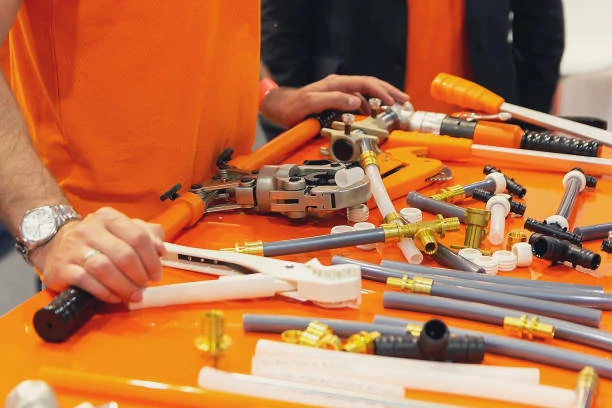PEX-AL-PEX pipes, known for their superior performance, have become a staple in modern plumbing, heating, and gas distribution systems. These multilayer pipes combine the benefits of cross-linked polyethylene (PEX) and aluminum, offering exceptional temperature resistance, pressure handling, and corrosion resistance. To achieve the high standards required in these applications, the production process of PEX-AL-PEX pipes must adhere to precise and sophisticated procedures. This article explores the detailed steps involved in the production of these advanced pipes.
1. Material Selection and Preparation
The production of PEX-AL-PEX pipes begins with the careful selection of raw materials. Manufacturers use high-density polyethylene (HDPE) as the base material for the PEX layers, while the aluminum layer requires pure aluminum with excellent formability and strength. To ensure the final product’s integrity, the production process involves thorough inspections of these raw materials for any impurities or inconsistencies.
Once selected, the HDPE undergoes a cross-linking process to enhance its thermal and mechanical properties. Cross-linking increases the material’s resistance to heat, chemicals, and pressure, making it ideal for demanding applications. The aluminum layer is prepared by rolling it into thin sheets, ensuring uniform thickness and strength across the entire surface.
2. Extrusion of the Inner PEX Layer
The production process then moves to the extrusion of the inner PEX layer. Extruders heat the cross-linked polyethylene pellets to a specific temperature, transforming them into a viscous state. This molten polymer is then forced through a die, shaping it into a continuous tube that forms the innermost layer of the PEX-AL-PEX pipe. The extrusion process requires precise control of temperature, pressure, and speed to ensure a consistent wall thickness and smooth surface finish.
After extrusion, the PEX tube undergoes cooling, typically by passing through a water bath or an air cooling system. This step solidifies the tube and locks in its dimensions, preparing it for the next stage of production.
3. Formation of the Aluminum Layer
Following the extrusion of the inner PEX layer, the production process adds the aluminum layer. A specialized machine wraps the aluminum sheet around the PEX tube, forming a seamless and continuous metal layer. The wrapping process requires extreme precision to avoid any overlaps, gaps, or wrinkles that could compromise the pipe’s structural integrity.
The aluminum layer not only provides a barrier against oxygen diffusion but also adds mechanical strength to the pipe. This layer allows the PEX-AL-PEX pipe to maintain its shape even under high pressure and prevents the permeation of gases, which is crucial in heating and gas distribution systems.
4. Bonding the Layers
To ensure the three layers (inner PEX, aluminum, and outer PEX) function as a single, cohesive unit, the production process involves a critical bonding stage. Manufacturers apply a special adhesive between the layers before they come into contact. This adhesive creates a strong bond that holds the layers together under various operating conditions.
The bonding process must ensure uniform application of the adhesive to prevent delamination, which could lead to pipe failure. This step also requires precise control of temperature and pressure to activate the adhesive and secure a lasting bond between the layers.
5. Extrusion of the Outer PEX Layer
With the aluminum layer securely in place, the final PEX layer is added through another extrusion process. This outer layer, like the inner one, consists of cross-linked polyethylene, providing additional protection against environmental factors and mechanical damage. The extrusion of the outer layer follows similar procedures as the inner layer, with careful attention to maintaining consistent wall thickness and surface quality.
The outer PEX layer not only protects the aluminum from physical damage but also provides an additional barrier against external moisture and chemicals, ensuring the pipe’s longevity.
6. Sizing and Cooling
After forming the complete PEX-AL-PEX structure, the pipe passes through a sizing stage, where it is brought to its final dimensions. This process involves pulling the pipe through a series of calibrated sizing dies, which ensure the pipe meets the required diameter and wall thickness specifications.
Following sizing, the pipe undergoes further cooling to stabilize its dimensions. This cooling process typically involves passing the pipe through a water bath or an air-cooling tunnel. The cooling stage is crucial for setting the pipe’s final properties, including its mechanical strength and flexibility.
7. Coiling and Quality Control
The final stage in the production of PEX-AL-PEX pipes involves coiling and quality control. The pipe is wound into coils of various lengths, depending on customer requirements. During this stage, the pipe undergoes rigorous inspections to ensure it meets all technical specifications.
Quality control checks include dimensional inspections, pressure testing, and visual inspections for surface defects. Manufacturers also test the pipe’s resistance to temperature extremes and chemical exposure, ensuring it can perform reliably in real-world applications.
Chinese PEX-AL-PEX pipe brand
| Brand | Founded | Addree |
| nectarplus | 1993 | shaoxing City, zhejiang Province |
| Jinde Pipe | 1999 | zhejiang City, Shanxi Province |
| Rifeng | 1996 | Foshan City, Guangdong Province |
| Kangtai Pipe | 1999 | Ningbo City, Zhejiang Province |
| Zhongcai Pipe | 1995 | Hangzhou City, Zhejiang Province |
Conclusion
The production of PEX-AL-PEX pipes involves a series of meticulously controlled processes, each contributing to the pipe’s final performance characteristics. From material selection and cross-linking to the precise extrusion and bonding of multiple layers, every step plays a crucial role in ensuring the pipe’s durability, flexibility, and resistance to various environmental factors. As a result, PEX-AL-PEX pipes have become a trusted solution in plumbing, heating, and gas distribution, delivering reliable performance in some of the most demanding applications.

